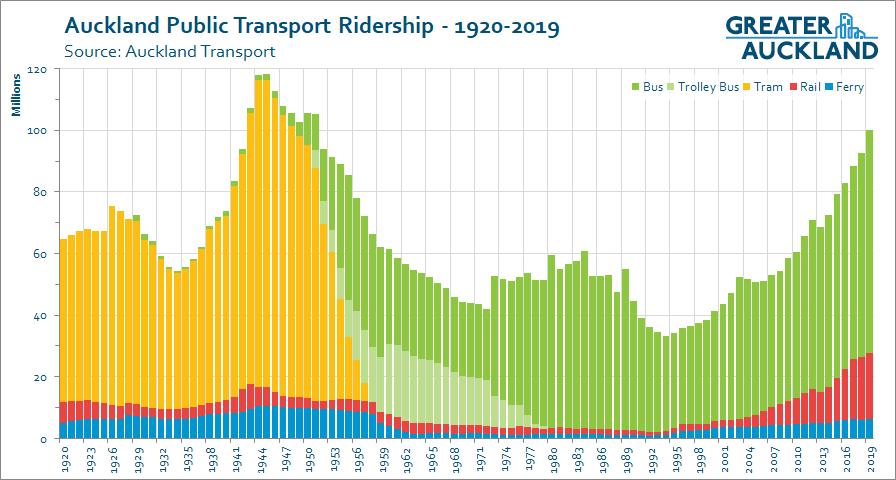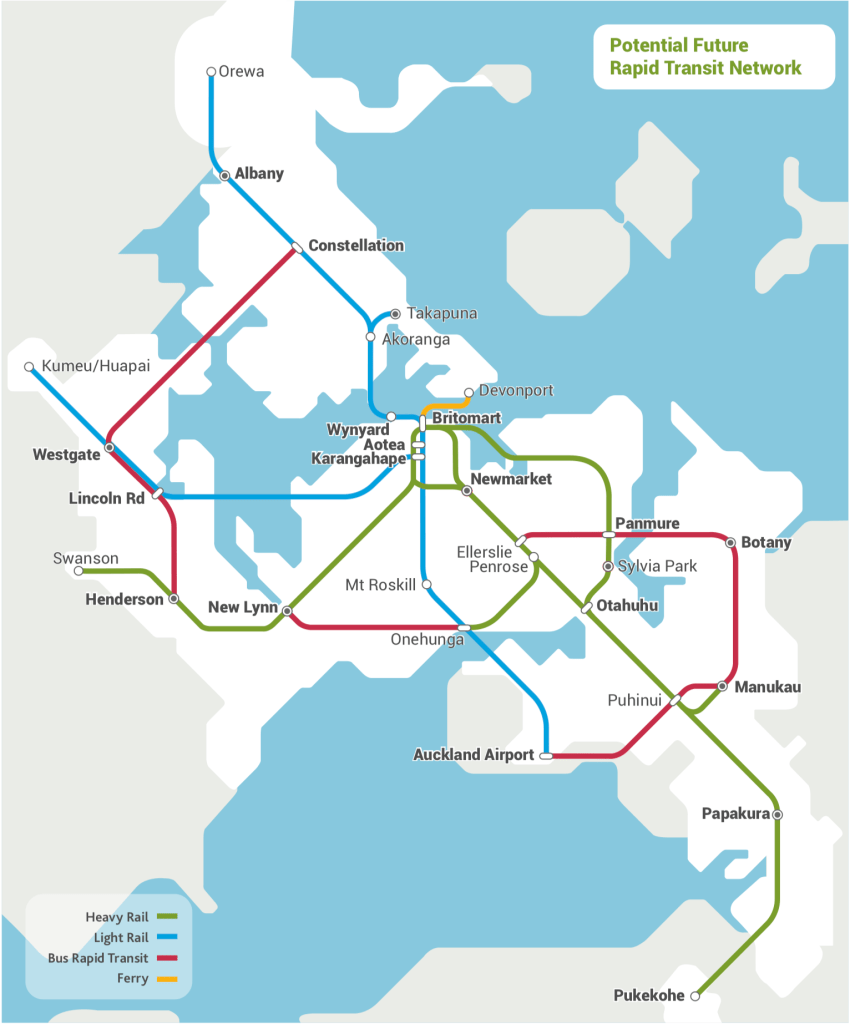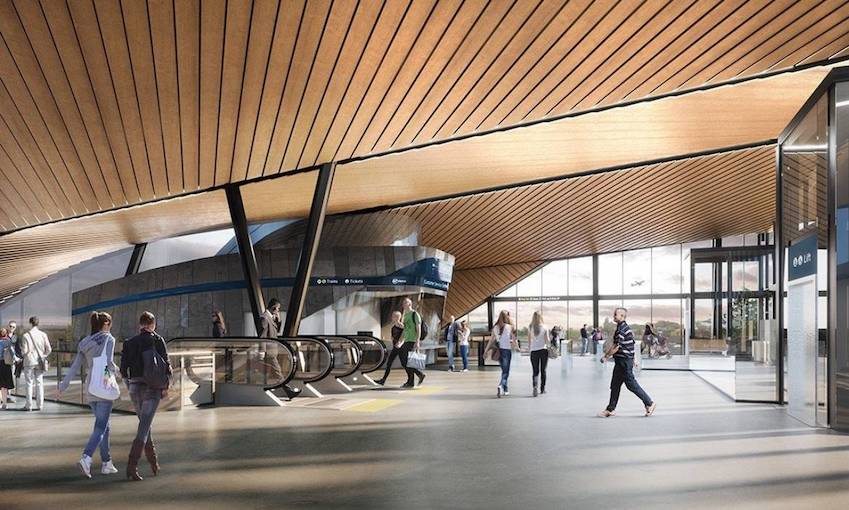The story of a revolution: How public transport transformed Auckland.
Public transport in Auckland looks set to hit an all-time of 100 million passengers this year. [Ed: It’s official, Wellington: we’ve lost our crown as public-transport capital of New Zealand.]
This post originally appeared on The Spinoff and Greater Auckland.
There’s a quiet revolution underway in Auckland, slowly but relentlessly transforming the city. It began early in the century – a big change of direction taken in small steps – and has been continued by every council and government since. It’s becoming an impressive and undeniable success and is changing a great deal about our biggest city. Its pattern and its possibilities, its international image, and its very idea of itself. Over the coming decade, this is set to really accelerate with a new scale and transformative force. Yet it is still invisible to many.
Mostly because it looks like a bus.
Or a train, or a ferry. Surprisingly, Auckland is actually becoming an effective public transport city, a city where more and more people can successfully live more of their lives without needing a car.
People are voting with their bums, increasingly putting them on public seats in public vehicles. From a low point of around 30 million annual trips in 1994, we’re about to hit 100 million this year – a number not seen since before the auto age, an increase well in advance of population growth.
This is no accident. It’s the result of many decades of hard work by different people from all sides of the political spectrum, especially in council but also in central government. After all, no one can choose to take a bus or a train that isn’t there.
This is a profound shift for anyone used to late 20th century Auckland, a city that had become, through strenuous official effort, one of the most car-focused cities outside the US. A place where public transport services had been allowed to wither to uselessness.
It isn’t that this new Auckland is available everywhere yet by any means. The quality of service is still patchy outside of the city centre, or places that happen to be along the revived rail lines and up the busway on the North Shore. Terrible transit shadows remain, especially in Mangere, East and Northwest Auckland. There are also other gaps and frustrations in between, such as slow or infrequent services, or poor stops and stations.
But the great news is that looking ahead to the funded programme for the next decade, these are actually being addressed.
Such a metamorphosis of a whole city takes time. Looking both into the past and into the future, we can see that we’re now around halfway through a 30-year programme of retrofitting full transit networks into a previously auto-dependent city.

To understand this journey we need to go back to the highly contested decision to bring trains back to lower Queen Street with the transformation of the grand old Chief Post Office building (CPO) into Britomart station. Opening in 2003, this began the revival of our then second-hand diesel train service by actually taking users close enough to where they needed to be: the city centre. Championed by Mayor Christine Fletcher but furiously opposed by her successor John Banks and others, this relatively small investment provided just enough evidence for the Clark-led government to commit to electrification and other upgrades to the suburban rail network, as well as the stunning urban regeneration of the space above the line.
The other early crucial enabler of this revolution was the construction – by that same government – of the Northern Busway. Opening in 2008 this was also loudly opposed. It was predicted to be a white elephant but instead was an instant and enduring success. Importantly, it showed that not only was it possible to add new rapid transit lines to places without historic routes (like rail lines), but it also put to bed forever the absurd claim that certain parts of town are ‘too posh to bus’. Everywhere, people will choose a service if it’s of high enough quality, especially if it’s really good – fast, frequent, safe and reliable transport.
Three important programmes started under the previous government continued under the new Key-led one: the amalgamation of local authorities, the introduction of the HOP card, and the electrification of the rail network. The creation of Auckland Transport (AT) in 2010 finally unified the delivery of transport services under one roof, enabling the coordination necessary to support all this growth.
The HOP card with integrated fares meant passengers only paid once for connected journeys across a number of different trips. It significantly reduced the cost barrier for many users, especially from further out or disconnected places.
Fancy new electric trains on better schedules have also been a huge success, driving a big jump in ridership. Since this upgrade, there have been no more extensions to the core faster Rapid Transit Network (RTN). Much of the growth has been on regular bus routes with AT redesigning the entire bus system while still delivering it, vastly improving its service and efficiency.

But now there are at last three new extensions to the top-tier network underway and the Busway is being extended to Albany. An Eastern Busway is being built to speed riders to trains at Panmure Station from Pakuranga, finally addressing this huge gap on the transit map. And a new interchange at Puhinui Station is being added (picture below), bringing seamless connection to an Airport busway for users of two of our three main rail lines.
Then there’s the City Rail Link, which the previous government and council committed to funding. This will double rail capacity and vastly improve the reach into the city centre for anyone along the rail network. This massive project, however, won’t be open until 2024. So in the meantime, other work is underway by AT to speed up and improve all those increasingly full buses on main arterial routes as buses still do the heavy lifting in Auckland.
The clear fact that we simply can’t keep adding more and more buses to our streets – especially not to the booming city centre – is among the reasons the current government saw that it needed to serve the other two big gaps in the top tier of the system: the North West and through the Isthmus and Mangere, need to be higher capacity Light Rail. These two lines, along with the Eastern Busway, will complete the doubling of the RTN from three to six lines, covering all points of the compass.
So while the work in the first decade or so of this revolution was relatively modest, their success worked as a proof of concept. The second half of the programme is going to complete the transformation much more quickly. The result of this will be revolutionary levels of choice for nearly all Aucklanders, the option to travel throughout the city without a car will be easier and more attractive.

Which is Auckland’s best hope to reduce carbon and other emissions as the city continues to grow. Because in our cities its cars, not cows, that are the greatest source of climate change gases. We need to make it possible to drive less, but to actually make it the best choice for more trips much more often.
This ambitious plan is already changing the shape of the city. Transport and land use influence each other reciprocally, and compact walkable cities need high-quality transit to support that car-lite urban form, and vice versa. Low-density sprawl is predicated on several cars in every garage and lots of space between and around buildings. Auckland has spent this entire century filling in. Even though we are still building houses at the end of the motorway, and experiencing the inevitable traffic congestion as a result, more than 75% of all housing growth has been with the existing urban area for two decades. This trend continues to accelerate.
What about the happy suburbanist and keen driver? Well, this is the best outcome for them too. Auckland has a saturated driving market. It has a mature road network on a constrained land mass and a high level of car ownership. Adding the complementary alternative networks to the driving ones enables this boom in PT ridership to continue, freeing up road space for those who choose or need to drive. This is especially important for vital service, goods, and emergency providers.
Great public transport is a necessary condition for a great city this century. Auckland is already achieving something truly remarkable with this globally significant success story. Transformation is an easy word to write but a hard one to actually achieve in across a whole city.
Auckland is giving it a lash.
Patrick Reynolds is an architectural photographer, transport and urban form advocate at Greater Auckland, and board observer at Auckland Transport.
Read the original on The Spinoff
Banner image: South Auckland’s Puhinui rail interchange visualised by Auckland Transport
Leave a comment